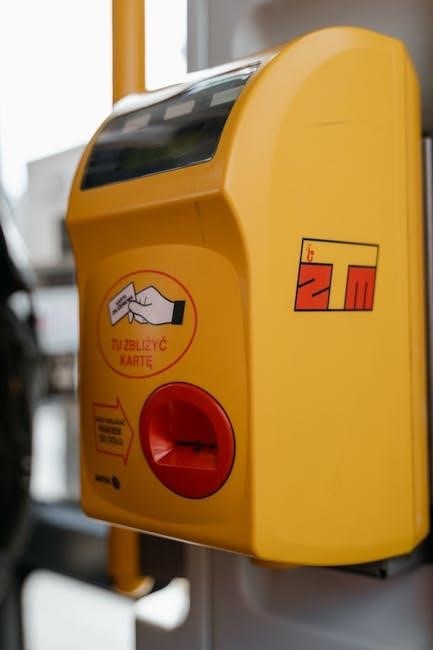The West Bend Air Fryer manual provides a comprehensive guide to understanding and utilizing your appliance effectively. It covers key features, safety precautions, and essential steps for optimal performance and maintenance, ensuring a seamless cooking experience.
Overview of the West Bend Air Fryer
The West Bend Air Fryer is a versatile kitchen appliance designed to offer a healthier alternative to traditional frying. It uses rapid air circulation technology to cook food with minimal oil, ensuring crispy results. Available in two models, AFWB12BK13 (12.6-quart) and AFWB7QBK13 (7-quart), it caters to different household needs. The air fryer features a user-friendly interface with preset guides and temperature controls for precise cooking. Its spacious basket allows for cooking a variety of foods, from fries to meats. Built with safety in mind, it includes a cool-touch exterior and secure lid. The manual provides detailed instructions for operation, maintenance, and troubleshooting, ensuring optimal performance and longevity of the appliance; It’s an ideal choice for those seeking a convenient and healthy cooking solution.
Importance of Reading the Manual
Reading the West Bend Air Fryer manual is essential for safe and effective use of the appliance. It provides critical information on safety precautions, proper operation, and maintenance. The manual outlines key features, such as rapid air circulation technology and preset guides, ensuring users understand how to maximize the air fryer’s capabilities. It also covers troubleshooting common issues and warranty details, helping users resolve problems efficiently. By following the manual, users can prevent accidents, optimize cooking results, and extend the appliance’s lifespan. Additionally, it guides users on initial setup, cleaning, and temperature settings, ensuring a seamless cooking experience. Referencing the manual is the best way to unlock the full potential of your West Bend Air Fryer while maintaining safety and performance.

Key Features of the West Bend Air Fryer
The West Bend Air Fryer features rapid air circulation, preset guides, large capacity, and versatility for healthy cooking. It includes safety features and easy cleaning.
Model Specifications (AFWB12BK13 and AFWB7QBK13)
The West Bend Air Fryer models AFWB12BK13 and AFWB7QBK13 offer distinct capacities to suit various cooking needs. The AFWB12BK13 features a 12.6-quart capacity, ideal for larger families or gatherings, while the AFWB7QBK13 provides a 7-quart capacity, perfect for smaller households. Both models utilize rapid air circulation technology for healthier frying with minimal oil. They include preset guides, temperature control, and user-friendly interfaces. The AFWB12BK13 is designed for versatility, accommodating multiple cooking functions, while the AFWB7QBK13 focuses on simplicity and efficiency. Both models emphasize safety with cool-touch exteriors and secure lids. These specifications ensure durability and optimal performance, catering to a wide range of culinary preferences and requirements.
Capacity and Versatility
The West Bend Air Fryer models AFWB12BK13 and AFWB7QBK13 are designed to meet diverse cooking demands with their spacious capacities. The AFWB12BK13 boasts a 12.6-quart capacity, making it ideal for preparing meals for larger families or social gatherings. In contrast, the AFWB7QBK13 offers a 7-quart capacity, perfect for smaller households or individual use. Both models are highly versatile, supporting a variety of cooking functions such as frying, baking, roasting, and dehydrating. The large cooking baskets allow for generous portions, while the rapid air circulation technology ensures even cooking results. These air fryers are perfect for accommodating different food types and quantities, providing users with flexibility and convenience in their culinary endeavors.
Rapid Air Circulation Technology

The West Bend Air Fryer utilizes advanced Rapid Air Circulation Technology to deliver crispy, fried-like results with minimal oil. This innovative system circulates hot air at high speeds around the food, ensuring even cooking and a golden finish. The combination of a powerful heating element and strategically designed air vents maximizes airflow, promoting uniform browning and texture. This technology also includes a top grill element that enhances browning for a more authentic fried flavor. By leveraging this efficient cooking method, users can achieve healthier, oil-free meals without compromising on taste or texture. The air fryer’s design ensures optimal air circulation, making it ideal for a wide range of dishes, from snacks to main courses.

Before First Use
Before first use, carefully unpack and inspect the air fryer, ensuring all parts are clean and free from damage. Follow the manual’s safety guidelines.
Unpacking and Initial Inspection
When unpacking your West Bend Air Fryer, carefully remove all components from the box and verify that no damage occurred during shipping. Check for any visible dents, cracks, or missing parts. Ensure all accessories, such as the basket and pan, are included and in good condition. Before first use, wash your hands and ensure the air fryer is placed on a stable, heat-resistant surface. Gently wipe the exterior and interior with a soft, damp cloth to remove any packaging residue. Inspect the power cord for any signs of damage and ensure all parts are clean and dry before plugging in the appliance. This initial inspection ensures safe and optimal performance.

Understanding the Product Diagram
The product diagram in the West Bend Air Fryer manual provides a detailed visual representation of the appliance and its components. It labels key parts such as the control panel, cooking basket, pan, and lid, helping users identify and understand each feature. Familiarizing yourself with the diagram ensures proper assembly and operation. The diagram also highlights essential elements like the power cord, ventilation openings, and safety features. By referencing the diagram, you can locate components quickly, such as the temperature control or preset buttons, and understand their functions. This visual guide is especially useful for troubleshooting or explaining how parts work together to ensure optimal performance. Take a few minutes to study the diagram to enhance your overall user experience and make the most of your air fryer.
Important Safeguards and Safety Precautions

The West Bend Air Fryer manual emphasizes several critical safety measures to ensure safe and efficient operation. Always read and follow the safety guidelines provided to prevent accidents. Key precautions include avoiding overheating by not leaving the appliance unattended and keeping children away from the air fryer while it is in use. Use oven mitts or tongs to handle hot baskets or food to prevent burns. Ensure the air fryer is placed on a heat-resistant surface and kept away from flammable materials. Regularly clean the appliance to avoid grease buildup, which can cause fires. Never submerge the base unit in water or use abrasive cleaners, as this may damage the electrical components. Adhere to these precautions to maintain safety and extend the lifespan of your air fryer.

Operating the West Bend Air Fryer
Operating the West Bend Air Fryer involves simple steps. Start by unplugging it, washing your hands, and placing food in the basket. Set the timer and temperature, then press Start. For optimal results, check food doneness without opening the basket excessively. Always follow the preset guide for precise cooking.
Using the Air Fryer for the First Time
Before using your West Bend Air Fryer for the first time, ensure it is properly unpacked and inspected for any damage. Place the air fryer on a flat, heat-resistant surface and plug it in. Wash your hands thoroughly and ensure the basket and pan are clean. Add your food to the basket, leaving enough space for air circulation. Set the timer and temperature according to the preset guide or your recipe. Press the Start button to begin cooking. During the cycle, you can check the food’s progress by pulling out the basket. Once done, unplug the air fryer and let it cool before cleaning. Always follow the manual’s instructions for optimal first-time use and to ensure safety.
Preset Guide and Temperature Settings
The West Bend Air Fryer features a convenient preset guide to simplify cooking various dishes. With models like the AFWB12BK13 and AFWB7QBK13, you can choose from preset functions such as Air Fry, Bake, and Dehydrate. Temperature settings range from 90°F to 400°F, allowing precise control for different recipes. For crispy fries, set the temperature to 400°F, while delicate foods like vegetables may require lower settings, around 300°F. Use the manual’s preset guide to adjust cooking times and temperatures for optimal results. Avoid overcrowding the basket for even cooking. Always refer to the preset guide for specific food recommendations to achieve the best outcomes with your West Bend Air Fryer.
Cooking Tips for Optimal Results
To achieve the best results with your West Bend Air Fryer, consider these essential cooking tips. For even cooking, cut food into uniform sizes and avoid overcrowding the basket. Shake smaller foods halfway through cooking to ensure uniform frying. Lightly coat fresh potatoes with oil for a crisper texture. Avoid extremely greasy ingredients like sausages, as they may not cook evenly. Stick to the recommended capacity of 500 grams (16 ounces) of fries for optimal results. Pre-made dough can speed up preparation. Always clean the air fryer after use to maintain performance. If food isn’t cooking evenly, adjust the time and temperature during the cycle. Check doneness by pulling out the basket, and resume cooking if needed. These tips ensure delicious and consistent outcomes every time.

Maintenance and Cleaning
Regularly clean your West Bend Air Fryer after each use to maintain performance. Use a soft sponge and mild detergent; avoid abrasive cleaners to prevent damage to non-stick surfaces.
Cleaning Your Air Fryer
Cleaning Your Air Fryer
Cleaning your West Bend Air Fryer is essential for maintaining its performance and longevity. After each use, unplug the appliance and let it cool slightly. Remove the basket and pan, and wash them with mild detergent and a soft sponge. Avoid using abrasive cleaners or metal scourers, as they may damage the non-stick coating. Wipe the exterior with a damp cloth and dry thoroughly. Regularly clean the air fryer’s interior to prevent food residue buildup. For tougher stains, mix equal parts water and vinegar in the pan and run a short cooking cycle. Always dry the air fryer after cleaning to prevent moisture accumulation. Proper maintenance ensures optimal functioning and hygiene for your air fryer.
Helpful Hints for Longevity
To ensure your West Bend Air Fryer lasts long, regular maintenance is crucial. After cleaning, always dry the appliance thoroughly to prevent moisture buildup. Avoid using metal utensils, as they may scratch the non-stick surfaces. Store the air fryer in a cool, dry place when not in use. For tough food residue, mix water and vinegar in the pan and run a short cooking cycle. Never submerge the base unit in water or use abrasive cleaners. Check for wear and tear on parts like seals and baskets, replacing them if necessary; By following these tips, you can maintain your air fryer’s performance and extend its lifespan. Proper care ensures consistent results and longevity for your West Bend Air Fryer.

Troubleshooting Common Issues
This section addresses common problems and provides practical solutions. Learn how to resolve issues like uneven cooking, temperature malfunctions, or slow dehydration with simple, effective fixes.
Identifying and Solving Common Problems
This section helps users address common issues with their West Bend Air Fryer; For uneven cooking, shake the basket halfway or adjust temperature settings. If the Dehydrate preset takes too long, ensure proper food slicing and air circulation. Check for obstructions in air vents and verify temperature settings. For oil-related concerns, replace oil after 5-7 uses to maintain quality. Avoid using abrasive cleaners to prevent damage. If issues persist, refer to the troubleshooting guide or contact customer support for assistance. Regular cleaning and maintenance can prevent many problems, ensuring optimal performance and longevity of your air fryer.
Warranty Information
Your West Bend Air Fryer is backed by a comprehensive warranty program designed to protect your investment. The warranty covers defects in materials and workmanship for a specified period, ensuring your appliance performs optimally. For most models, the warranty period varies depending on the component, with the main unit typically covered for 1-2 years, while accessories like the basket and pan may have a shorter warranty duration. To claim warranty service, you must provide proof of purchase and contact West Bend’s customer support team. Damage caused by misuse, improper cleaning, or unauthorized modifications is not covered. Visit the official West Bend website for detailed warranty terms and conditions, or refer to the manual for specific instructions on filing a claim.

Additional Resources
Access downloadable PDF manuals, product specifications, and FAQs for your West Bend Air Fryer on the official website or trusted manual databases for enhanced support.
Downloading the PDF Manual
To access the West Bend Air Fryer manual, visit the official West Bend website or trusted manual databases like Manua.ls. Simply search for your specific model, such as AFWB12BK13 or AFWB7QBK13, and download the PDF version for free; These manuals are designed to provide detailed instructions, product specifications, and troubleshooting guides to ensure optimal use of your air fryer. The manuals are available in English and have been rated highly by users for clarity and comprehensiveness. For convenience, you can also find direct links to these resources on the West Bend website or through the Manua.ls platform, ensuring easy access to the information you need to get the most out of your appliance.
FAQs and Customer Support
The West Bend Air Fryer manual includes a dedicated FAQ section to address common questions and concerns. Topics range from troubleshooting issues, maintenance tips, and optimal cooking practices to understanding specific features like preset guides and temperature settings. Additionally, West Bend offers customer support for users needing further assistance. You can visit their official website or contact their support team directly for personalized help. The manual also directs users to online resources, such as Manua.ls, where they can find additional FAQs and detailed product information. This comprehensive support system ensures that users can resolve issues quickly and make the most of their air fryer experience.






























